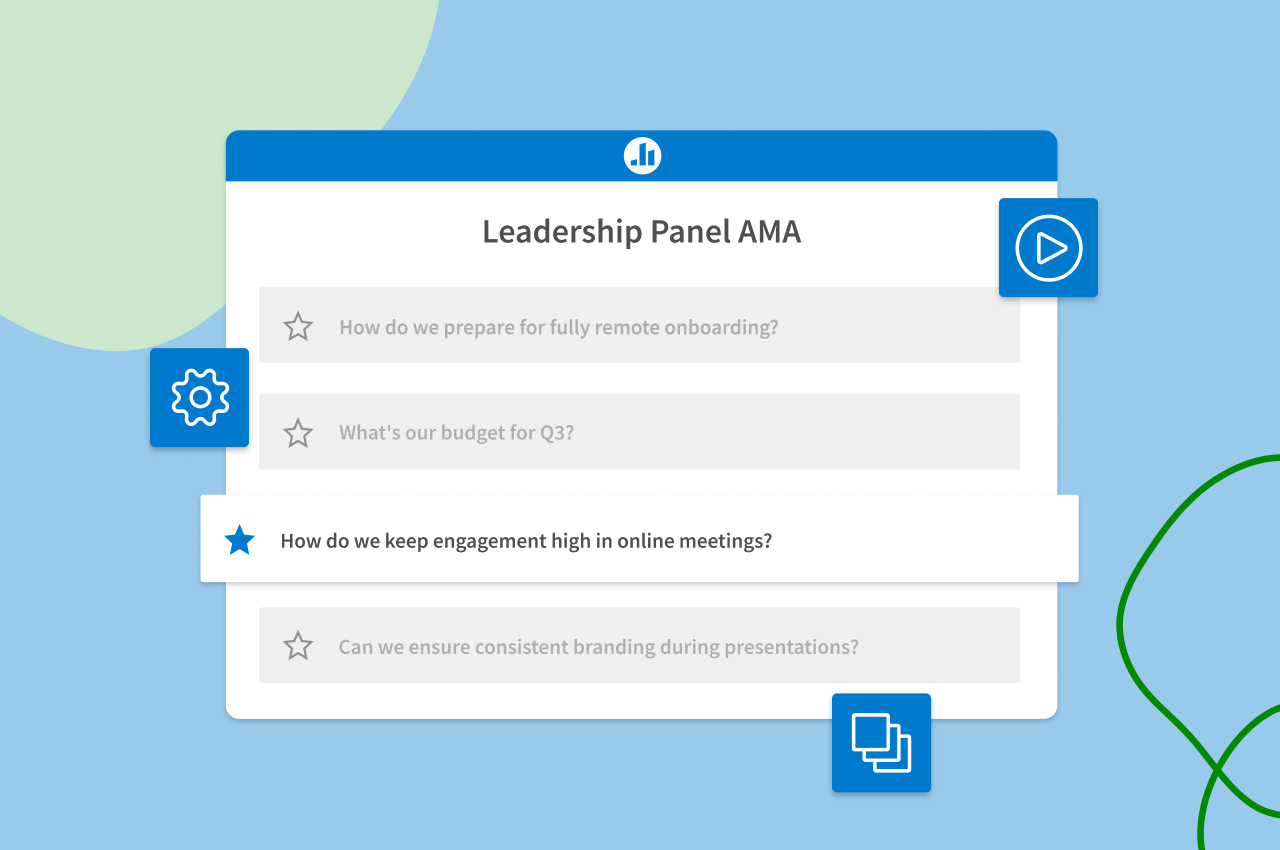A deep dive into the 17 drivers of employee engagement

“Find a job that you enjoy doing, and you will never have to work again in your life.” — Unknown.
But even if you enjoy your job, it might not feel this way. Most employees are constantly under pressure in today’s high-powered work environment, making it harder to truly enjoy their activities. This is why only 21% of employees are actively engaged in their jobs.
Plus, this level of low engagement costs the global economy $7.8 trillion, or 11% of the annual global GDP. When you consider the dire consequences of low employee engagement, it becomes necessary to understand what really drives it.
Without fully understanding what drives employee engagement in your organization, you’re missing out on opportunities to re-energize your workforce and increase its value.
We’ve listed 17 drivers of employee engagement to help you navigate this challenge and devise engagement initiatives with hard-hitting data.
Common challenges with employee engagement
In the book Managing Human Resources by Scott Snell (Professor of Business Administration, University of Virginia) and Shad Morris (Professor of Business, Brigham Young University) define employee engagement as “the extent to which employees are enthused about their work and committed to it.”
But this can be challenging to achieve when employees are already dealing with issues like insurmountable workloads, long working hours, and subsequent burnout.
There are several other reasons why employees are not actively engaged. Some of them include the following:
- Poor internal communication: When managers or team members can’t communicate well, it’s hard to understand what’s expected. It leads to decreased internal alignment and a lack of motivation.
- Lack of growth opportunities: Nobody wants to feel stuck in a dead-end job. If there’s no path forward, employees will feel disengaged and unmotivated.
- Lack of one-on-one meetings: If you don’t get regular feedback on your work, it’s difficult to gauge whether you’re on the right track. One-on-one meetings solve this issue, which is why it’s important to include them. They give managers and employees an open platform to review performance without any disruptions while building loyalty through meaningful interactions. It also allows managers to get to know their employees on a personal level.
- No workplace transparency: Too often, senior leadership and employees work as separate entities with no alignment on goals or objectives. When there’s no transparency on company initiatives, goals, or even daily activities, employees will slowly detach from the environment.
- No recognition or rewards: A lack of recognition from senior leaders or co-workers could make an individual feel left out. For instance, acknowledging a job well done or rewarding the team with food could do wonders to make them feel appreciated.

17 key drivers of employee engagement in the workplace
Here are the top drivers of employee engagement to help you motivate, involve, and retain employees in the long run:
1. Recognition
Everyone loves feeling seen—especially when they go above and beyond at their job. It can be proved by the fact that employees who feel recognized are 56% less likely to look for a new job and 73% less likely to feel burned out.
When they feel seen, they’ll continue to put their best foot forward to reap the rewards in the long run. For instance, at Poll Everywhere, we host weekly “Coffee in the Kitchen” hangouts that are meant for us to get to know each other. Our People Ops team also hosts an Annual Company Awards show to recognize the contributions of different individuals and teams.
2. Communication
An open communication culture that encourages transparency makes everyone feel involved. It ensures that managers can convey what needs attention and how to navigate it, leaving no room for misinterpretations. Plus, it encourages team members to communicate more often, ensuring things get done faster and with more clarity.
3. Collaboration
A 2006 study identified collaboration as a critical driver of employee engagement. According to the study, when individuals and teams forego self-interest and focus on shared goals, they can outperform teams that don’t instill such employee relationships. It fosters trust and commitment, which increases internal engagement.
4. Empowerment
When you hire employees, you indicate faith in their abilities and judgment to do their job. But they’ll lose interest if they feel they have to take permission before making minor decisions or managing their own time.
A 2020 study found that the more employees feel like they have autonomy, the more engaged and creative they are. Micromanagement is the antithesis of autonomy, which is why managers need to avoid micromanaging their employees. Empower your employees with the right resources and room to exercise their decision-making abilities to keep them invested.
5. Feedback
Providing constructive feedback is crucial. Employees need to know where they’re going wrong and what they’re doing right. By conducting regular one-on-one sessions or team meetings, managers can offer employee feedback and suggestions for improvement. It ensures that they handle things before it’s too late while also ensuring that employees’ efforts are being recognized in the workplace.
6. Workplace culture
In 2022, the quiet quitting trend took the world by storm. Quiet quitting is when employees stop subscribing to the “hustle culture” mentality and perform their bare minimum duties. This happens when companies don’t think about how company culture impacts the engagement levels of individual employees.
However, when companies create a positive work culture, it encourages employees to go above and beyond in their roles. This is why leadership needs to invest time and resources into creating a healthy work environment. As a result, they’ll attract employees that thrive in such an environment, creating a self-sustaining positive work culture.
7. Resources
The Job Demands Resources theory was postulated by Arnold Bakker (Chair of the Center of excellence for Positive Organizational Psychology, Erasmus Universiteit Rotterdam) and Evangelia Demerouti (Professor of Human Performance Management, Eindhoven University of Technology). It states that there are two drawbacks in working conditions that can decrease employee engagement: a highly demanding job and a lack of resources to complete the job.
Both tend to create psychological and motivational health impairment. Employees with too much on their plate but no support to complete these tasks stress out and eventually disengage. Instead, you can get them actively involved by offering benefits like training, co-worker support, and task support.
8. Work-life balance
If you’re bombarding employees with messages and calls at odd hours of the day, even the most engaged employees will lose their enthusiasm. In addition, a lack of support to accommodate personal issues like illnesses could cause them more stress.
Such shortcomings can disrupt their work-life balance, as they’re overworking themselves with no time to recuperate. It’s one of the reasons why 18% of executives believe stress and/or burnout is one of the main reasons people quit.
This is why companies invest in resources to prevent burnout and foster a healthy work-life balance. It’s the key to enabling job satisfaction and creating motivated employees who stay with the organization.
9. Health & well-being
In their 1997 paper, Christina Maslach (Professor of Psychology, University of California, Berkeley) and Michael P. Leiter (Organizational Psychologist and Adjunct Professor, Acadia University) define burnout as “an erosion of engagement.” With time, challenging work becomes meaningless while turning energy into physical exhaustion.
One of the first theories of employee engagement was developed by William A. Kahn, Professor of Management & Organizations at Boston University. It stated that when employees experience psychological safety, they tend to feel more engaged too. It means they should feel safe voicing their opinions, taking responsibility and performing their duties without feeling like they’re upsetting others.
Ultimately, disengaged employees check out physically and mentally. Offering flexibility, a safe work environment, and encouraging a healthy work-life balance could improve overall engagement.
10. Direction & purpose
The Institute of Employment Studies defines employee engagement as “a positive attitude held by the employee towards the organization and its values.”
The study emphasizes the two-way nature of employee engagement. As employees feel aligned with the company’s values, goals, and mission, they feel like they have a role to play in its success. They’d be more invested in day-to-day activities and regularly participate in adjacent activities.
11. Fulfillment
Apart from psychological safety, Kahn’s paper identified two other psychological functions of employee engagement: psychological meaningfulness and psychological availability.
In terms of meaningfulness, if employees find value in their job and overarching responsibilities, they’re more likely to be engaged and fulfilled. Every individual looks for a sense of purpose in life. If their job gives them that, it bodes well for them and the organization. The more inspired they are, the more motivated they are at work.
12. Leadership
Typically, the organization’s leadership sets the tone for workplace culture and policies. This is why employees look up to their leaders to gauge if the place is the right fit for them. If leaders work towards a positive work culture, employees tend to be more engaged.
A top-down approach is necessary for this purpose. A recent study found that 33% of retention-focused human resources leaders invest more in employee engagement.
13. Growth & development
Keeping employees engaged is only possible if they have a clear idea of what their progress looks like for them within the organization. For instance, if they envision a promotion next year but your company isn’t offering such development opportunities, they might lose sight of their work.
If not progression, at least offer opportunities for skill improvement and on-the-job training. A report on high-performing teams found that 30% of tech employees are motivated by learning & development (L&D) opportunities.
On the other hand, 34% of HR leaders aim to prioritize L&D in the next 12 months. Ultimately, when leaders invest in such initiatives, it shows employees that they care about their career development.
14. Role & responsibilities
Ideally, to find meaning and value in employees’ work, they need to feel like they’re the right fit for the role.
A 2015 study found that when person-job fit and person-organization fit occurs, it improves the individual’s positive attitude. In turn, it increases their attitude toward work through improved engagement. The better the fit, the longer they’ll stay at the organization.
15. Managerial support
The employee-manager relationship is another huge driver of engagement. Even if the organization is an excellent fit, if an employee is stuck with a non-communicative or toxic manager, they lose sight of all the benefits the organization offers.
Managers should employ people-oriented management methods like entrusting them with responsibilities and paying attention to their immediate needs. The increased social exchange empowers the employee, increasing their active participation.
16. Transparency
Transparency is crucial for a healthy work environment. Using this approach, leaders can create an environment of trust that boosts morale, productivity, and loyalty. It’s also why 59% of HR leaders are investing in workplace transparency efforts.
With more transparent systems in place, companies can avoid costly disruptions due to misinformation. Ultimately, it improves engagement and reduces employee turnover.
17. Compensation & benefits
Giving employees fair compensation and adequate benefits helps them feel financially secure. It also makes them feel like they’re being treated fairly and in line with their expectations/experience.
Also, 67% of employees want pay transparency, while only 25% know the pay band for their job level. By increasing transparency around these initiatives and compensating accordingly, you can help them feel valued.
While the relationship between increased salary and engagement is not linear, investing in the right person pays off in the long term.

Improve employee engagement with Poll Everywhere
Considering that 32% of HR leaders say that their People Ops teams use employee engagement as a business metric, you can see how critical it is.
It’s a complex issue, and the drivers of employee engagement can vary from organization to organization. But by understanding the challenges associated with the drivers to motivate employees, you can develop thoughtful strategies to engage your teams.
You can employ engagement tools like Poll Everywhere to check in with your teams using polls or surveys. For instance, conduct an employee engagement survey using the Activities feature. These easy-to-design interactive polls help you reach out and get a feel of what’s happening without too much effort on your part. It can help you gauge the current workplace atmosphere and identify points of contention in the organization.
Sign up for Poll Everywhere today to kickstart your employee engagement initiatives or chat with a representative to learn more about our Enterprise offerings.